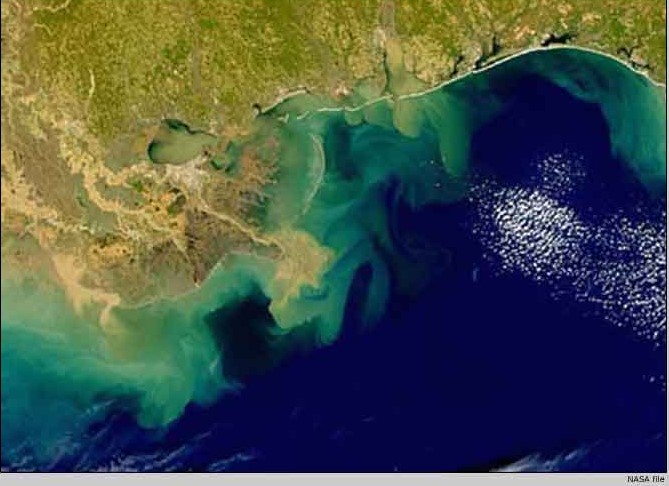Case Study 2.4: Gulf of Mexico: Dead Zone
This case study examines a recurring problem that’s been plaguing the Gulf of Mexico (GOM): the annual formation of the Dead Zone, an area characterized by hypoxia, low dissolved oxygen (DO) levels in the water column that threaten Gulf marine life. While there are many scientific aspects to consider, we’ll focus on three of the most important: (1) the behavior of the key nutrient nitrogen (N) in Mississippi River watershed soils; (2) the transport of nitrates through the Mississippi River to the Gulf; and (3) the impacts of elevated nitrate levels on the GOM ecosystem.
We’ll conclude by looking at some options for reducing nitrate levels in the Mississippi. Along the way, we’ll look in depth at research being done on various aspects of this recurring problem.
Before you start, review some of the Background Materials on the Gulf of Mexico and its infamous Dead Zone presented here.

Background Materials:
Two good sites for background on the GOM are http://www.epa.gov/gmpo/about/facts.html
and http://www.gulfbase.org/facts.php. Both contain links to other useful web sites.
Also visit http://www.treehugger.com/natural-sciences/48-facts-you-should-know-about-the-gulf-of-mexico-from-sunken-ships-to-ancient-corals.html for some fascinating tidbits on the Gulf. For instance, did you know that there are 29 species marine mammals found in the Gulf? How many can you name?
Dead Zone Background: A good review of hypoxia (Dead Zone formation) and its causes is available from the Louisiana Universities Marine Consortium at http://www.gulfhypoxia.net/Overview/.
A US EPA web site (http://water.epa.gov/type/watersheds/named/msbasin/zone.cfm) gives
an update on the GOM Dead Zone formation in recent years and also contains some good
graphics and links to related web sites.
GOM Research: Visit http://www.gulfhypoxia.net/Research/Shelfwide Cruises/2015/ to check out the latest “Shelfwide Cruise” which is taken each summer to determine the extent of annual Dead Zone formation.
Nitrogen in the Mississippi River Watershed: Web sites that provide useful information on the issue of nitrogen include US EPA’s http://water.epa.gov/type/rsl/monitoring/upload/EPA-MARB-Fact-Sheet-112911_508.pdf
and http://www.msrivercollab.org/focus-areas/nitrogen-phosphorus-pollution/. This site from the Mississippi River Collaborative includes useful information on some of the federal regulations that are being used to attempt to control inputs of nitrogen within the basin.
Textbook References and Links:
Innovative Solutions:
The Iowa Initiative wetland restoration program: http://www.ewg.org/news/testimony-official-correspondence/dead-zone-action-needed-ewg-remarks-hypoxia-task-force
The USDA’s Natural Resources Conservation Service’s Mississippi River Basin Healthy Watersheds Initiative: http://www.nrcs.usda.gov/wps/portal/nrcs/detail/ga/programs/?cid=nrcs142p2_020764 OR
http://www.nrcs.usda.gov/wps/portal/nrcs/detailfull/national/home/?cid=STELPRDB1048200
Dr. Nancy Rabalais is one of the leading members of the research community working on the
GOM Dead Zone. Visit https://www.youtube.com/watch?v=AVxF074FpqU to see a video
featuring some of her early work on the Dead Zone.
Downloadable data and files:
Exercise 2: GOM case study data EX2.txt
Exercise 3: GOM case study data EX3.txt
Exercise 5: GOM case study data EX5.txt
Open Maps Gallery (at maps.google.com/gallery) to explore our collection of content. Use the search box to find a map or browse to find content in the gallery.


